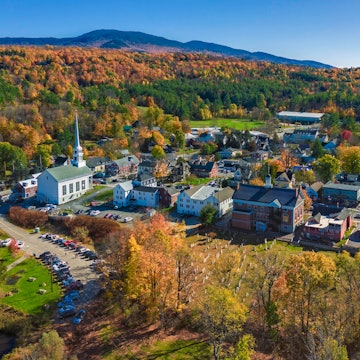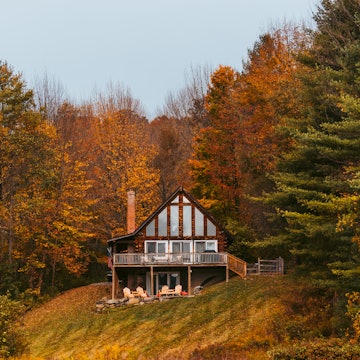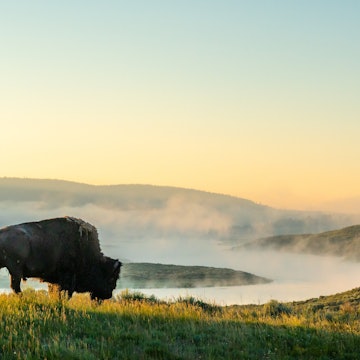
10 of the most spectacular waterfalls at Yellowstone National Park and how to see them

Apr 13, 2022 • 8 min read

While Yellowstone's Lower Falls might be the park's most popular waterfall, it is one of hundreds © Kelly Cheng Travel Photography / Getty
Located primarily in Wyoming, Yellowstone National Park sprawls its 2.2 million acres of spectacular and wild beauty into parts of Montana and Idaho, too, and is one of the largest parks in the US National Park Service.
This hotspot of geothermal activity (the most of any place on the planet!) is home to such iconic sights as Old Faithful geyser and Mammoth Hot Springs. Established in 1872, Yellowstone National Park is also the oldest national park in the United States.
In addition to geysers that blow their lids on the regular and pools that bubble with 50 shades of blue (and very dangerous) beauty, Yellowstone is a place with cold water in abundance, too – cascades, curtains and veils of it gush down in varying intensities all over the park. So if you’ve come to chase waterfalls, you’re in a great spot for it here.
Experience Yellowstone National Park sustainably: your guide to going green
How many waterfalls are there in Yellowstone National Park?
Yellowstone National Park spokesperson Linda Veress says quantifying how many waterfalls actually exist within the park is tricky. Some might be minimal or seasonal cascades while others gush hundreds of millions of gallons of water per day throughout the year. But Veress says that it’s safe to say there are scores upon scores of waterfalls located within the park. Quantifying which is the most beautiful or best to visit is really a subjective thing, however. To make the most of your time in the park, she advises, come with an open mind and see which scenery strikes you most.
“There’s something to be said for discovery as you’re driving through the park,” says Veress. “You might see a waterfall that speaks to you.”
Whatever you do and wherever you go, she says, be sure to hike responsibly, stay on trails and remember to throw out your trash. And be aware, too, that you’re sharing the park with some of North America’s wildest nature.
“Yellowstone has a healthy grizzly bear population,” Veress says. “So be sure to carry bear spray and hike in groups of three people or more.”
I'm a Yellowstone guide — here's what you need to know if you plan on visiting in 2022
These are the best waterfalls in Yellowstone National Park:

Lower Falls: best for the highest falls
Height: 308 feet
The fastest way to see the falls: Drive along the one-way loop east of Canyon Village. There are several viewpoints and a strenuous walking trail that leads to the top of the falls for a closer look.
Part of the area called the Grand Canyon of the Yellowstone, Lower Falls is the celebrity waterfall of Yellowstone National Park – the poster child for how beautiful gushing white water with superlative natural surrounds can be. So get your camera ready, because she’s gorgeous from any mist-spraying angle.
Lower Falls plunges down from a 308-foot-high precipice, unleashing more than 60,000 gallons of water per second when its flow is most forceful, during the springtime months (come autumn, the gush dwindles to about 5000 gallons per second, which is of course still nothing to scoff about).
15 unforgettable experiences in US national parks
Crystal Falls: best overlooked waterfall
Height: 129 feet
The fastest way to see the falls: You can see Crystal Falls from the South Rim Trail, just east of the Upper Falls Viewpoints area.
Located in the Grand Canyon of the Yellowstone between showier Upper and Lower Falls, Crystal Falls often gets overlooked by visitors bee-lining it between its more famous bookends.
But this elegant, three-step cascade impresses those who seek it out since it’s one of the prettiest in the park – and plunges quite dramatically to a gushing river snaking its way along the canyon floor.
7 best US national parks to take your kids

Mystic Falls: best for geothermal surrounds
Height: 70 feet
The fastest way to see the falls: It’s a 2.4-mile moderate hike (there and back) along a trail to reach these falls. To reach the trailhead, walk .3 miles to the far side of the Biscuit Basin boardwalk.
Gushing from the Little Firehole River in the Upper Geyser Basin of Yellowstone National Park, Mystic Falls rushes through a geothermally-heated area where it’s typical to see steam rising from the surroundings, lending an even more magical look to the scenery.
The trail to reach the falls puts the joy in the journey, too, as you walk through mixed conifer forests where wildflowers erupt along the path during the summer months.
America's 'pocket planet': exploring Yellowstone National Park

Silver Cord Waterfall: best horsetail-type waterfall
Height: 1200 feet
The fastest way to see the falls: Hike along the Seven Mile Hole Trail (accessed from the Glacier Boulder Trailhead near Inspiration Point) for roughly one mile to get your first views of Silver Cord Cascade.
Waterfalls don’t have to be wide to be wondrous. Case in point, this “horsetail” style waterfall that looks, from a distance, like a chalk-white line drawn down the sheer cliffs. The cascade is fed by Surface Creek, which flows out of Ribbon Lake on the South Rim of the Grand Canyon of the Yellowstone. From its sinewy look to the cadre around it, the whole scene is wondrous.
North America's best national park day hikes

Firehole Falls: best falls for swimming downstream
Height: 40 feet
The fastest way to see the falls: Take Firehole Canyon Drive through Firehole Canyon (off the Grand Loop south of Madison) and look for the overlook.
Canyon walls formed by lava flows are the bookends for Firehole Falls, which peters out into a stiller scene downstream at the Firehole Swimming Area, accessed by stairs that lead down to a rocky beach. Despite the falls’ name, balmy waters don’t await swimmers here. Temperatures are chilly, and it’s only advisable to attempt swimming during the warmer months of summer.
Introducing the United States' 63 national parks

Fairy Falls: best waterfalls for a day hike
Height: 200 feet
The fastest way to see the falls: From the Fairy Falls Parking Lot, off Grand Loop Road, walk 1.6 miles to reach the falls.
It’s a gorgeous walk through lodgepole pine forest to reach Fairy Falls in the park’s Midway Geyser Basin area, where Fairy Creek spills over the edge of the rocky and tree-lined Madison Plateau in a graceful and misty stream.
The bottom of the falls flow over a series of rocky faces, lending an elegant, tiered finish to the original drop. As with everywhere in the park, be sure to be bear aware along this trail.
Yosemite vs Yellowstone: which national park is best for you?

Upper Falls: best for waterfall for up-close views
Height: 109 feet
The fastest way to see the falls: Drive south from Canyon Village onto South Rim Drive and park in the first big parking area on the left. Then make the short walk to the Upper Falls Viewpoint.
This punishing rush of water located in the Grand Canyon of the Yellowstone, upstream from the more celebrated Lower Falls, is a wonder in its own right (if not nearly as tall).
What’s particularly invigorating for waterfall chasers at Upper Falls is that you can take the steep Brink of the Upper Falls trail ⅛ of a mile down from the viewpoint to stand tantalizingly close to the cliff edge, where the water thunders straight down in the most delightfully dramatic way.
15 unforgettable experiences in US national parks
Undine Falls: best for families
Height: 60 feet
The fastest way to see the falls: You can see the falls from the roadside four miles east of Mammoth Hot Springs. Or else hike for a closer look by parking at Lava Creek Picnic Area to access the Lava Creek Trail (less than one mile, roundtrip).
Drive four miles east of Mammoth Hot Springs to reach this easily viewed roadside waterfall that’s a favorite for road-tripping families to visit thanks to an easy hike that awaits. You can get a closer view of Undine Falls with just a short (less than a mile, round trip) and flat hike to it from the parking lot.
The three-tiered cascade pounds into a tight canyon and is surrounded by towering pine trees. The hiking path erupts with wildflowers from June into roughly mid-July, making the short walk all the more worth it.
The top 10 most visited national parks in the US

Tower Fall: best for photography fun
Height: 132 feet
The fastest way to reach the falls: Walk 1/10 of a mile from the parking area on Grand Loop Road to Tower Fall Overlook.
Photographers of the amateur and more experienced variety will have fun playing with their shutter speeds to capture this steep-drop waterfall that descends uninterruptedly from 132 feet.
While the base of Tower Fall is hidden by foliage, the lush surrounds paired with spiky rock spires above the falls (some people say they look like alligator teeth) lend a lot of interest to the fall’s backdrop. It’s a hard place to take a bad photo – and a good place to zoom in or out and have fun capturing your own unique view.
The best one-day itineraries for 5 US national parks
Kepler Cascades: best for accessibility
Height: 150 feet
The fastest way to see the falls: Drive south of Old Faithful roughly 2.5 miles along the Firehole River and the Grand Loop Road until you reach the Kepler Cascade overlook.
Pull into the parking lot right off the road and you’ll be able to catch a glimpse of this three-tiered roadside waterfall that doesn’t require any amount of hiking at all to appreciate. You can even see the mist from the falls from your car if you park close enough. But it’s worth stepping out, of course, to breathe in the fresh air and let your senses bask in the sounds and sights of rushing water just doing its gravity-induced thing.
Everything you need to know about paddling in Yellowstone National Park
You might also like:
8 US national parks where you can scuba dive
The complete guide to Yellowstone National Park
15 unforgettable experiences in US national parks















